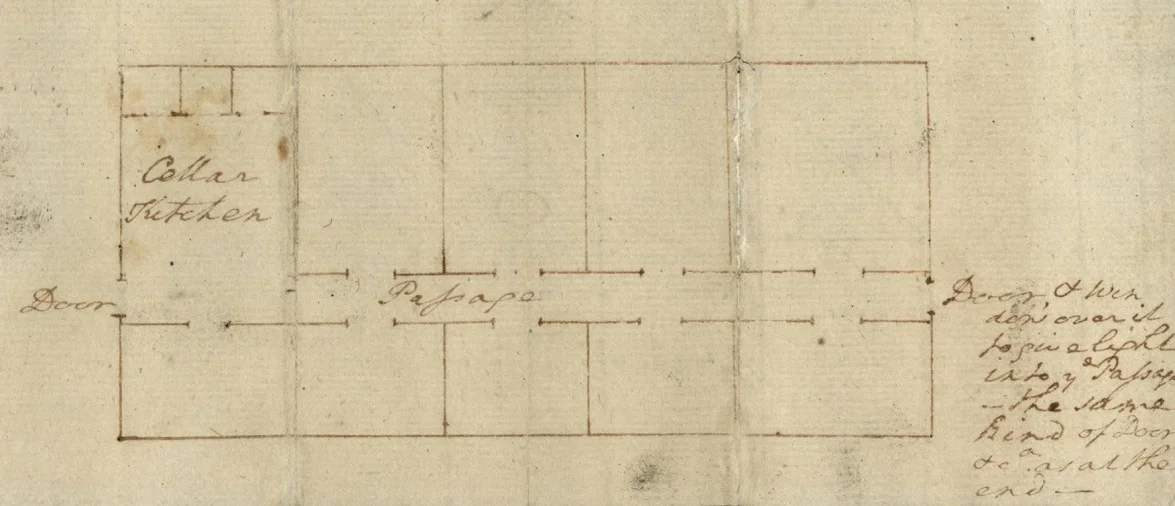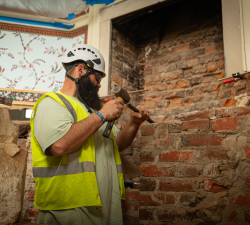The grounds and estate will remain open for the duration of this project.
From 2023-2026, Mount Vernon is embarking on a landmark preservation project to safeguard the Mansion’s original building fabric and ensure its structural integrity for generations to come.
Visitor Impact
Red shading indicates spaces that are off-view. These timeframes are estimates and may change.
A History of Preservation
When the Mount Vernon Ladies’ Association (MVLA) took possession of George Washington’s home in 1860, it faced a monumental restoration challenge. Much of the Mansion was already a century old, and for nearly as long, it had been a site of pilgrimage for many visitors. The accumulated wear and tear of thousands of visits challenged the ability of the Washington heirs to maintain the house, leaving it “much dilapidated and out of repair,” according to one 1858 visitor. Supplemental timbers propped up the sagging piazza. It would take time, hard work, and significant funds to return the estate to its former glory.
Over the subsequent decades, the MVLA has meticulously restored the Mansion and surrounding outbuildings and, in the process, has turned Mount Vernon into a shining example of historic preservation. It is through these painstaking efforts that the Mansion exists today.
Now, after extensive investigation, assessment, research, planning, and design, Mount Vernon is taking proactive steps to ensure the health of the Mansion as it enters its fourth century.

Frequently Asked Questions
How will this project affect my visit to Mount Vernon?
An enclosed work area will be fenced to the north of the Mansion for the duration of this project. As work progresses through the house, individual rooms will be taken off display temporarily, and the path of tours through the Mansion will change depending on the work that is underway. For up-to-the-minute details about closures, project progress, and discoveries, visit our Preservation in Action page.
Why are you undertaking this project?
For several reasons:
1. The Mansion is being asked to perform functions for which it was not designed. Built as a private residence, it is now a public monument visited by thousands of people each day, which translates to a much heavier traffic flow than the Washingtons could have imagined. That increased traffic flow causes wear and tear and strain on the building fabric.
2. Although repairs throughout the Mansion’s history have been accomplished using the best techniques available at the time, some of those repairs are now more than a century old. Significant advances in preservation technology afford exciting opportunities to improve structural and environmental conditions in the building, preparing it for another century of service.
3. Some of the earliest interventions completed in the Mansion were “localized” repairs, intended to solve specific problems of immediate concern. Though successful, such repairs can have unintended consequences that affect the overall health of the Mansion. With this project, Mount Vernon’s preservation team is proceeding holistically, approaching the Mansion as a complex network of interlocking systems.
What are the major tasks of this project?
1. Designing and installing a new heating/ventilation/air conditioning system (HVAC) for the Mansion
2. Improving drainage in and around the Mansion's cellar
3. Repairing sections of the Mansion’s framing and masonry

Why does Mount Vernon need a new HVAC system?
Installing a new HVAC system will accomplish several things:
1. Mount Vernon had installed an HVAC system in 1999; it is now outdated and inefficient.
2. The new HVAC system will provide climate control for the cellar for the first time in its history. Over many years, humidity in the cellar has damaged some original materials, particularly soft Aquia sandstone blocks used in the original foundations. The new system will address fluctuating humidity levels, creating a more stable environment.
3. Each room of the Mansion has distinct environmental needs, based on its location relative to the exterior and the amount of sunlight received. By creating multiple environmental zones, the HVAC system will provide more precise environmental control in individual rooms. The new system will also increase the capacity for both humidification and dehumidification.
4. HVAC ductwork in the cellar will be relocated underground and out of sight, facilitating improved stewardship and interpretation. Mount Vernon preservation staff will be able to conduct maintenance on the cellar’s west wall, which is currently inaccessible. Removal of the ducts will also allow for a full and accurate interpretation of the cellar. In George Washington’s time, the cellar was used for a variety of functions, including the storage of supplies and foodstuffs. There is also evidence the cellar housed a kitchen for the individuals assigned to serve the Washington household, and it probably served as quarters for an enslaved man named Frank Lee, who is known to have acted in the capacity of “butler,” and his family.
Modern ductwork and electrical conduits in the Mansion's cellar have made areas of this historic space inaccessible for regular inspection. Removal of these systems will allow for regular maintenance and a fuller, more accurate interpretation of the cellar. (MVLA)
How are you addressing drainage issues?
Moisture infiltration, in the form of rain or groundwater, has been an issue in the Mansion cellar since Washington’s time. Washington designed a system of underfloor drains to manage moisture from rain and groundwater that worked well into the modern era until necessary structural reinforcements to the Mansion’s framing in the late 19th and early 20th century obstructed portions of the system. The revitalization work will create new underfloor drains to carry away any water that may permeate through the foundation walls.
Detail view of one 18th-century drain cutting through an even earlier 18th-century drain. The drains were exposed during archaeological excavations in the Cellar Passage. The earlier drain curves to form a corner roughly outlining the northeast corner of the early house. The excavations exposed several drainage systems and early foundation walls. (MVLA)

Why do you need to repair the Mansion’s framing?
Traditional timber framing features an integrated system of horizontal elements (sills, girders, joists, and plates), vertical elements (wall studs and posts), and diagonal braces. These elements lock together to create a rigid structure that resists lateral forces.
By the late 19th century, moisture and termites had damaged a number of these elements at the first-floor level. Localized repairs resolved the immediate problems but inadvertently impacted the integrity of the original structural system, requiring other elements of the structure – exterior sheathing boards, interior lath and plaster – to provide lateral resistance. Replacing non-original floor joists and sills and reconstituting the joinery between elements will enable the structure to again function as intended by 18th-century carpenters.

And masonry?
The brick and stone foundation walls and chimney bases in the cellar provide the strong underpinning upon which the Mansion stands. As with the framing, some necessary interventions, completed with modern materials, have proven to be unsympathetic to the original fabric of the house, slowly causing unintended damage. Masonry repairs will include:
1. Replacing modern “Portland cement” with a soft, lime mortar, like that used in the original construction. Masonry is comprised of brick or stone blocks held together by a binder called mortar. The brick and stone used during the 18th century were soft, and they required a soft mortar. The reason for this is when moisture infiltrates a masonry wall, it will eat away at the softest part, ideally the mortar, which can be replaced much more easily than brick or stone. The moisture in the Mansion cellar wore away the soft mortar (as it should have), but when repairs were made, instead of using soft mortar, hard mortar containing water-resistant “Portland cement” was used. This hard mortar was the standard type used for all construction during the 19th and 20th centuries, and so it was also commonly used to repair historic houses. It has unfortunately proved to be far too hard for the soft brick and stone of 18th-century buildings. Its water-resistant properties have forced moisture into the brick and stone, exacerbating degradation of these materials.
2. Replacing later brick piers. As the Mansion’s first-floor framing aged, it began to sag, a situation worsened by multiple generations of repairs. To shore up the sagging timbers, more than 30 brick piers were added in the cellar in the 19th and 20th centuries, significantly altering the appearance of the spaces. Once the framing and masonry repairs have been completed, most of these piers will no longer be needed and will be removed. Those that are still needed will be replaced by less conspicuous supports, bringing the cellar closer to its 1799 appearance.
This digital rendering depicts the cellar in its current state. The 19th- and 20th-century brick piers, most of which will be removed, appear in white. (MVLA)
How long will it take?
This multi-stage project will require at least three years to complete.
What was the first phase of this project?
The project began in early 2023 with an expansion of the existing underground utility bunker located north of the Mansion. Over a period of six months, this bunker was enlarged by 65 percent to house the mechanical components of the new HVAC system.
As is standard before any major construction project at Mount Vernon, the Archaeology team had previously excavated this area in search of archaeological features and evidence of past human activities. Discoveries from this excavation, which took place in 2022, included pre-Colombian projectile points (arrowheads and spear points); a variety of 18th-century English, German, and American ceramic table wares; two “large cent” coins bearing dates of 1798 and 1817; and objects associated with decades of tourism to Mount Vernon.
Archaeological excavations will continue throughout the project, preceding any work that involves breaking ground. The Archaeology team is currently excavating portions of the Mansion's cellar.
Below, take an inside look at the first phase of the Mansion Revitalization Project—from archaeological excavation to the completion of the new underground bunker.
How can we keep up with this project as it proceeds?
To learn about the work being done (and any exciting discoveries along the way), visit the Mansion Revitalization Blog and our In-Depth Look webpage.
We will also be posting regular video updates, which can be seen below!
An In-Depth Look
As Mount Vernon's Mansion Revitalization Project proceeds into 2026, take a deep dive into the various aspects—and unexpected discoveries—of this landmark preservation project.
Learn more


































































